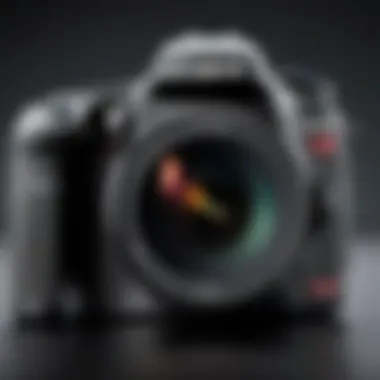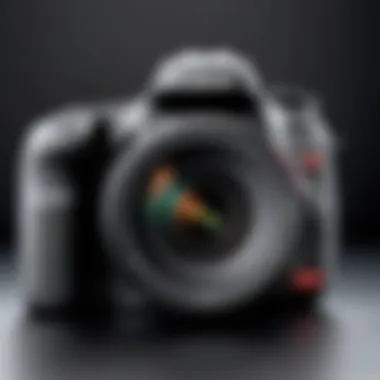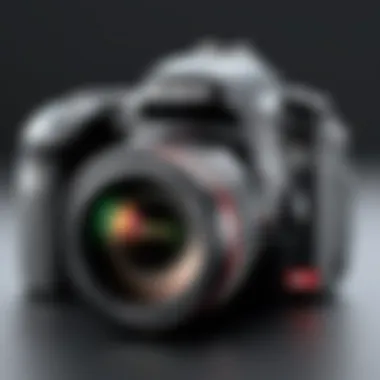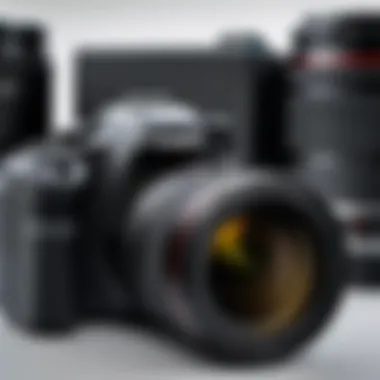Exploring Canon USA DSLR Cameras: A Comprehensive Guide


Intro
The photography landscape has evolved significantly, with Canon USA at the forefront of digital single-lens reflex (DSLR) technology. This guide aims to navigate the intricate details of Canon's DSLR offerings, shedding light on their features, specifications, and how they compare with competitors. We will also discuss the accessories that can elevate the photography experience with Canon DSLRs.
Understanding the nuances of DSLR cameras is critical for both amateur photographers and professionals alike. Known for their reliability and performance, Canon DSLRs cater to a broad audience. They range from entry-level models for beginners to advanced systems tailored for seasoned photographers. This comprehensive exploration will provide insights that can assist in making informed decisions when selecting a camera.
Overview of the Product
Purpose and Benefits
Canon USA's DSLRs are designed to bridge the gap between casual photography and professional artistry. They combine user-friendly interfaces with high-quality imaging capabilities. The primary benefit is the control they offer over settings such as aperture, shutter speed, and ISO. This level of control enhances the photographer's ability to create stunning images in diverse conditions.
Target Audience
The target audience for Canon DSLRs includes:
- Amateur Photographers: Individuals seeking to enhance their skills without overwhelming complexity.
- Professionals: Seasoned photographers looking for reliable workhorse cameras.
- Videographers: Those interested in capturing high-definition video alongside high-quality stills.
Key Features
Key features of Canon DSLRs include:
- Interchangeable Lenses: The ability to switch lenses based on shooting requirements enhances versatility.
- Optical Viewfinder: Provides a direct view of the scene, aiding composition.
- Large Image Sensors: Lead to better low-light performance and depth of field control.
- Advanced Autofocus Systems: Ensure precise focusing, critical for action shots.
Technical Specifications
Detailed Product Specs
Canon offers a range of models, each with specific technical specifications that cater to various needs. For example, the Canon EOS 90D features a 32.5 MP sensor, while the EOS Rebel T8i has a 24.1 MP sensor. Such differences influence image quality and usability under various lighting situations.
CPU Characteristics
The processing power of Canon DSLRs is vital for performance. Models like the EOS-1D X Mark III incorporate sophisticated DIGIC processors that allow for faster image processing and enhanced performance in continuous shooting modes.
GPU Features
While DSLRs do not have dedicated GPUs like computers, their image processors significantly enhance image rendering. This is crucial when processing RAW images for professional use.
Memory Details
Most Canon DSLRs support dual memory card slots. This feature allows for extensive storage options, enabling users to capture large numbers of images without interruption.
Performance Benchmarks
In performance benchmarks, Canon DSLRs have impressed photographers with their consistency in autofocus speed and accuracy, even in low light. The continuous shooting speed is also noteworthy, with some models reaching up to 20 frames per second.
Comparison with Similar Products
Market Competitors
Canon faces competition from brands like Nikon and Sony, each offering unique features. Nikon's D7500, for example, is known for its high ISO performance, while Sony's A7 series presents strong video capabilities.
Comparative Analysis
When comparing models, factors such as image quality, autofocus systems, and ergonomics are imperative. Canon provides a robust menu system and an intuitive layout that many photographers find appealing.
Best Use Cases
Choosing the best use case for these cameras depends on the user's aspirations. For casual photography, the EOS Rebel series may suffice. For professional work, the EOS R5's 8K video capabilities come into play.
Installation and Setup Guide
Requirements for Installation
Setting up a Canon DSLR requires minimal effort. Users need:
- A fully charged battery
- A memory card compatible with the model
Step-by-Step Process
The setup process generally involves:
- Inserting the memory card and battery.
- Turning the camera on.
- Adjusting the language settings in the menu.
- Selecting the appropriate shooting mode based on experience level.
Tips for Optimizing Setup
For optimal performance, it is advisable to:
- Regularly update the camera firmware.
- Customize user settings to streamline frequently used features.


Answers to Common Questionss and Troubleshooting
Common Issues and Solutions
Photographers may experience issues related to focusing or image quality. Common troubleshooting steps include cleaning the lens contacts and resetting the camera settings to default.
Expert Tips
For capturing the best images, experts recommend:
- Familiarizing oneself with the manual settings for better control.
- Practicing shooting in different lighting environments to understand the camera’s performance.
Intro to Canon DSLR Cameras
Canon DSLR cameras represent a significant segment in the world of photography, offering a blend of advanced technology and user-friendly designs. Understanding these cameras is crucial for anyone interested in photography, whether a novice or a seasoned professional. This section introduces the reader to the depth of Canon's offerings, highlighting why these particular cameras stand apart in a saturated market and what makes them a preferred choice for many.
History of Canon DSLRs
Canon's journey in the DSLR arena began in the late 1980s, with the introduction of the Canon EOS-650, which was one of the first autofocus SLR cameras. Over the years, Canon has consistently pushed the boundaries of camera design and technology. Throughout the 1990s and 2000s, Canon earned a reputation for innovation with models such as the EOS-1D series, favored by professionals for their speed and reliability. Today, their DSLRs range from entry-level to professional models, catering to a wide audience. An important aspect of this history is Canon's approach to developing lenses and accessories alongside their camera bodies, ensuring a comprehensive ecosystem for photographers.
Significance of Canon in Photography
Canon's influence in photography extends beyond just the cameras they offer. The brand is synonymous with quality, launching numerous iconic models that have won the loyalty of millions. They played a crucial role in the digital transition, with early digital SLRs like the EOS D30 setting new standards for image quality. Canon's robust lens selection remains unmatched, making it a top choice for photographers looking to achieve various artistic styles. Their commitment to research and development has also kept them ahead in features such as image stabilization and autofocus technology.
Canon DSLRs have significantly shaped the photography landscape, consistently offering models that not only meet but exceed the expectations of users at every level.
Current Canon DSLR Models
Understanding the category of current Canon DSLR models is essential for anyone looking to invest in a camera that meets their needs. The landscape of camera technology has evolved significantly, and Canon has managed to keep pace by offering a range of models suited to various skill levels and photographic requirements. By delving into the models available today, one can appreciate the distinct features and benefits they provide, which will aid in making an informed decision.
Entry-Level DSLRs
Entry-level DSLRs by Canon cater to beginners and those who want to start their journey into photography without overwhelming complexities. Models like the Canon EOS Rebel T8i provide a balance between usability and functionality. These cameras often include built-in guides to help users understand basic photography concepts while enabling full manual control once they advance.
- Features:
- 24.1 MP sensor for quality images
- Dual Pixel autofocus for quick focusing
- Vari-angle touchscreen for versatility.
Many entry-level models also support connectivity options, allowing users to share their work effortlessly. This accessibility is crucial as it encourages newcomers to explore and excel.
Mid-Range DSLRs
Mid-range DSLRs offer a significant upgrade from entry-level options, incorporating advanced features that appeal to more experienced photographers. The Canon EOS 90D exemplifies this category. It provides enhanced performance, yet remains user-friendly.
- Specifications:
- 32.5 MP sensor for improved resolution
- Excellent low-light performance
- Continuous shooting speed of up to 10 frames per second.
This category often appeals to hobbyists and semi-professionals who require more control over their work yet do not need the extreme specifications reserved for professional bodies. Versatile lens options also enhance the creative possibilities.
Professional DSLRs
For professionals, Canon offers high-end models like the Canon EOS-1D X Mark III. These are built for demanding environments and rigorous use cases, providing exceptional durability along with advanced features.
- Advantages:
- 20.1 MP full-frame sensor for outstanding image quality
- Superior autofocus with 191 AF points
- Robust weather-sealed body for durability.
Professional models cater to those requiring top-tier performance for commercial work or serious projects. They often incorporate cutting-edge technology that ensures reliability in demanding situations.
Comparison of Recent Models
When considering which Canon DSLR to purchase, it becomes essential to compare recent models to identify the best fit. Each model serves distinct purposes, and understanding these differences can guide a decision effectively.
- Quick Comparison:
- The EOS Rebel T8i is ideal for newcomers focusing on simplicity.
- The EOS 90D provides features for enthusiasts wanting more control.
- The EOS-1D X Mark III meets the needs of professionals needing reliable performance.
Every model presents unique advantages and limitations. Evaluating these attributes allows buyers to choose a camera that aligns with their skill levels and photography goals.
Choosing the right Canon camera model is not just about specifications; it’s about finding the right balance for your creative process.
Key Specifications of Canon DSLRs
Understanding the key specifications of Canon DSLRs is vital for discerning consumers. These specifications influence everything from image quality to performance. A carefully selected camera can elevate user experience and output in photography. When considering a purchase, these elements weigh heavily on the final decision. The more familiar you are with them, the better your choices will be.
Sensor Types
Canon DSLR cameras are equipped with various sensors, primarily focusing on APS-C and full-frame types. The APS-C sensors are smaller, making lenses appear to have a longer focal range due to the crop factor. This suits those who want better telephoto reach without spending excessively on optics. Full-frame sensors deliver superior image quality, especially in low light. They provide a broader dynamic range and better control over depth of field. In essence, the choice of sensor type significantly influences the overall shooting experience. Using the wrong type for your needs can lead to dissatisfaction.


Image Quality
Image quality is a paramount consideration for any photographer. Canon DSLRs consistently provide excellent image quality across different ranges. Factors such as resolution, dynamic range, and color accuracy are essential. Higher resolution allows for larger prints and cropping flexibility. Canon's dedicated effort to optimize color reproduction helps photographers capture scenes true to life. Furthermore, advanced noise reduction technology enhances performance when shooting at high ISO settings, making low-light photography more viable. Quality indeed matters when you want to capture memories that last.
Autofocus Systems
Autofocus systems in Canon DSLRs have evolved impressively over the years. Canon utilizes both phase-detection and contrast-detection systems. Phase-detection AF is generally faster, making it suitable for dynamic scenes, while contrast-detection AF excels with precise focusing in still scenarios. Many modern models incorporate Dual Pixel AF technology, which allows for smooth and fast focusing during video recording. This adaptability is critical for capturing sharp images, especially in situations where movement is present. An effective autofocus system can significantly impact your final results, and understanding it can aid in selecting the right camera.
Video Capabilities
Video capabilities in Canon DSLRs have surged in relevance with the rise of content creation. Many models now offer 4K video recording, enabling filmmakers and vloggers to produce high-quality content. Frame rates and codecs can vary, affecting recording flexibility and quality. Features such as external microphone inputs and clean HDMI output are crucial for serious videographers. Additionally, stabilization features, either in-camera or through compatible lenses, enhance video quality by minimizing shake. High video capabilities should not be overlooked, as they can significantly broaden the utility of a DSLR.
In summary, understanding the key specifications of Canon DSLRs allows potential buyers to make informed choices that best suit their needs. Knowing the trade-offs and advantages of each specification helps one navigate their purchase without regret.
User Experience with Canon DSLRs
User experience is a crucial aspect when assessing Canon DSLRs. It encompasses several factors that contribute to the overall satisfaction of users. Understanding ergonomics, camera interface, and adaptability in photographic styles all play a significant role in how photographers interact with their gear. This section will highlight the importance of these elements and how they serve the needs of various users.
Ergonomics and Build Quality
Ergonomics refers to how comfortable and user-friendly a camera is during operation. Canon DSLRs are designed with the user in mind. Their shape and layout are oriented toward enabling a natural grip. Many models offer textured surfaces that provide extra hold, especially essential for long shooting sessions.
Build quality is another crucial factor. The materials used in construction often indicate the durability of the camera. Canon typically uses a mix of polycarbonate and magnesium alloy, allowing their cameras to be light yet robust. This ensures they can withstand various environments, making them suitable for both amateur and professional photographers.
Key Points on Ergonomics:
- Comfortable grip for extended use.
- Intuitive button layout allows quick adjustments.
- Lightweight designs promote mobility.
These elements combine to create a shooting experience that feels effortless. Photographers often note that the balance and weight distribution make handling the camera a delight.
Camera Interface and Usability
The camera interface is essential for navigating settings and functions efficiently. Canon's user interface is generally considered intuitive. Most users find their way around the menus with relative ease. This is particularly helpful when time is of the essence in capturing the perfect shot.
Many Canon DSLRs feature customizable buttons, allowing users to prioritize functions they use the most. Having quick access to settings like ISO or focus points can significantly enhance a photographer's efficiency.
Interface Highlights:
- Clear display screens with easy-to-read information.
- Customization options tailored to user preference.
- Logical organization of menus.
Usability extends to the overall experience. A user-friendly camera allows photographers to focus on their creativity rather than getting bogged down by complex settings.
Photographic Styles and Applications
Another significant aspect of user experience is how well a camera adapts to various photographic styles. Canon DSLRs cater to a wide range of genres, from portrait and landscape photography to sports and wildlife. This versatility is one of Canon’s key strengths.
With various modes available, photographers can easily switch settings based on their needs. For example, the “Night Portrait” mode allows for capturing the finer details in low-light situations, while “Action” modes optimize the camera for fast-moving subjects.
Applications to Consider:
- Portrait photography benefits from the depth of field control.
- Landscape photographers appreciate the expansive color range.
- Sports photography is enhanced by fast autofocus systems.
By understanding these applications, users can unlock the full potential of their Canon DSLRs. This level of adaptability ensures that whether you are a seasoned professional or a novice, the camera can successfully meet your photographic needs.
The user experience with Canon DSLRs is designed to enhance creativity without hindrance. A comfortable grip, intuitive interface, and supportive features for various styles contribute to an enriched photography journey.
Benefits of Choosing Canon DSLR
The decision to choose a Canon DSLR can be pivotal for both novice photographers and seasoned professionals. Canon's commitment to innovation and user satisfaction plays a significant role in this choice. Several key aspects benefit users, ensuring they find value in their investment.
Lenses and Accessories Compatibility
One of the foremost reasons for selecting a Canon DSLR is the extensive range of lenses and accessories compatible with its systems. Canon offers a myriad of options, from standard zoom lenses to specialized macro and telephoto options.
- The robust EF and EF-S mount systems support a wide variety of lenses. Users can easily switch between lenses without compatibility issues.
- Compatibility extends to third-party brands like Sigma and Tamron, broadening access to innovative photography tools.
- Various accessories, such as tripods, filters, and external flashes, are designed specifically for Canon cameras.
This extensive ecosystem allows photographers to tailor their gear to specific photography styles, making it easier to achieve desired results amid various shooting conditions.
Quality Control and Durability
Another compelling factor in choosing Canon DSLRs is their acclaimed quality control and durability. Canon has maintained high standards in manufacturing, ensuring that each unit meets stringent performance criteria.
- Cameras are built using durable materials that withstand adverse photography environments. Reliability in various conditions allows users to focus on their craft rather than worry about equipment failure.
- Canon DSLRs often come with weather-sealed bodies, which provide protection against dust and moisture. This feature is particularly beneficial for outdoor photographers engaging in nature shoots.
- Infusing technology such as advanced image stabilization mechanisms enhances longevity and performance quality.
Such attention to detail and resilience reinforces user confidence, allowing for exploration in diverse environments while maintaining optimal output quality.
Extensive User Community and Support
The Canon user community stands out for its activity and support, providing an invaluable resource for both beginners and experts. Being part of this community enriches the user experience significantly.


- Users benefit from shared knowledge and tips via forums like reddit.com, where community members discuss best practices and troubleshooting.
- Canon provides excellent customer support resources, including online guides and troubleshooting articles. The support network ensures users are not left stranded when they face challenges.
- Canon hosts workshops and educational content, aiding users in maximizing their creativity and technical skills.
The depth of community engagement and resources allows Canon DSLR owners to develop their skills continually and receive assistance when needed. The result is a positive feedback loop that encourages growth within the photography field.
In summary, selecting a Canon DSLR aligns with a commitment to quality, durability, and a vibrant support network, all critical elements for anyone serious about photography.
Canon DSLR Accessories
Understanding Canon DSLR accessories is crucial, as they enhance the overall photography experience. Accessories help improve camera performance, protect equipment, and expand creative possibilities. They are essential for both beginners and seasoned photographers. By choosing the right accessories, users can maximize the capabilities of their Canon DSLRs.
Essential Accessories for Beginners
For those new to photography, starting with the right accessories can make a significant difference. Here are some essential accessories every beginner should consider:
- Extra Batteries: Photography sessions can be long. Having spare batteries ensures that the camera does not run out of power at crucial moments.
- Memory Cards: A good quality memory card is vital for storing high-resolution images. It is advisable to have multiple cards to manage large volumes of photos.
- Tripod: A sturdy tripod is key for long exposure shots, low-light conditions, or self-portraits.
- Camera Bag: Protecting the camera from damage is important. A well-padded camera bag will keep all accessories organized and safe during transport.
- Basic Lens Filters: Filters can protect lens surfaces from scratches and dust. They can also enhance image quality in various lighting conditions.
These accessories play an essential role in ensuring that beginners feel confident and prepared.
Advanced Accessories for Professionals
Experienced photographers often need specialized accessories to elevate their work. Here are some advanced options:
- High-Quality Lenses: Professionals benefit from investing in additional prime or zoom lenses. Each lens offers unique capabilities, allowing for varied artistic expression.
- External Flash Units: Advanced lighting can dramatically improve photo quality, especially in low-light settings. External flashes provide better control over light.
- Battery Grip: This accessory extends battery life and enhances grip, making it easier to shoot in portrait orientation.
- Remote Shutter Release: For precise shooting, especially during long exposures, a remote release minimizes camera shake.
- Lighting Kits: Professional setups often require multiple light sources, which can greatly enhance image quality.
Such accessories allow professionals to produce high-quality, refined work.
Software for Editing and Management
Beyond hardware, software plays a significant role in the photography workflow. Good editing software allows photographers to refine their images post-capture. Some popular choices include:
- Adobe Lightroom: This software offers comprehensive image management, allowing for efficient photo sorting and powerful editing features.
- Adobe Photoshop: For detailed editing tasks, Photoshop is one of the most powerful tools available.
- Capture One: This program is excellent for tethered shooting and provides high-quality raw conversion and editing capabilities.
- Photo Mechanic: A fast image browser is useful for quickly culling and selecting photos before editing.
Investing in software is equally important as upgrading camera hardware.
It is critical to acknowledge that the right accessories can not only improve the quality of your photographs but also enhance your overall shooting experience. Understanding what to select based on your skill level can greatly impact your photographic journey.
Canon USA Services and Support
Canon USA offers a range of services and support options that significantly enhance the ownership experience of their DSLR cameras. The intricate nature of photography equipment often necessitates a strong support system. Users of Canon DSLRs benefit not only from high-quality products but also from comprehensive service options designed to address their needs. This section details the crucial aspects of Canon USA's services and support, highlighting warranty and repair services alongside customer support resources.
Warranty and Repair Services
Canon provides robust warranty and repair services that are vital for maintaining the performance of their DSLR cameras. Generally, Canon DSLRs come with a limited warranty that covers defects in materials and workmanship for a period of usually one year. This warranty is not just a statement of confidence; it ensures that users have access to repair services without incurring additional costs during the warranty period.
The process for accessing warranty coverage is straightforward. Users need to retain their original purchase receipts and register their product online through the Canon website. This registration facilitates a smoother experience if a repair is required.
In case of repair needs, Canon offers several options:
- Authorized Service Centers: Canon has a network of authorized service centers that are qualified to handle repairs. These centers use genuine Canon parts, ensuring the camera is restored to its original condition.
- Mail-In Repair Service: For those unable to visit a service center, Canon provides the option to send their camera in for repairs.
- On-Site Service for Professionals: For professionals who rely heavily on their equipment, Canon offers on-site service options, minimizing downtime in critical situations.
Understanding the details of the warranty is essential for users to navigate potential issues effectively.
Customer Support Resources
Canon's customer support resources are designed to assist users throughout their photography journey. Comprehensive support is crucial as it directly impacts user satisfaction and can determine continued loyalty to the brand. Canon provides a variety of channels for users to seek help:
- Online Support: The Canon website hosts a wealth of information, including FAQs, troubleshooting guides, and how-to articles. Users can easily access this information to resolve common issues independently.
- Live Chat and Email Support: These tools provide quick and efficient responses to more complicated questions. Users can discuss their issues with a support representative, who can guide them through problem-solving.
- Phone Support: For immediate assistance, Canon offers phone support where users can speak with knowledgeable representatives. This direct communication can often resolve issues faster than other methods.
- Community Forums: Engaging with fellow Canon users through community forums, such as those on Reddit or dedicated photography websites, can foster a sense of belonging and provide insights and tips from experienced photographers.
Canon USA places a significant emphasis on customer support, as they recognize the importance of trust and reliability in retaining customers.
Epilogue
The conclusion section serves as a pivotal point in this comprehensive guide to Canon USA's DSLR cameras. It encapsulates the insights provided throughout the article, reinforcing the substantial role that Canon plays in the photography landscape.
In examining Canon's DSLRs, one discovers not only the technical specifications but also the user benefits that are inherent in these cameras. The amalgamation of features such as ergonomic design, autofocus systems, and high image quality facilitate a seamless photography experience. These advantages resonate well with various skill levels, from amateurs to seasoned professionals.
Additionally, the article emphasizes the importance of accessories. A camera is only as good as the gear that accompanies it. Choosing the right lenses, tripods, and editing software can transform an average photograph into a stunning visual piece. Canon's commitment to support and warranty further contributes to consumer confidence in their product longevity and reliability.
Overall, the concluding remarks delve into the broader implications of selecting a Canon DSLR. Readers should consider how these cameras fit into their unique photography styles and needs, weighing their various features against personal or professional goals. Making an informed decision can lead to enhanced creative expression and satisfaction.
Final Thoughts on Canon DSLRs
As we draw to a close, it becomes evident that Canon DSLRs hold a considerable standing in the camera market. They represent a rich heritage of innovation, astute engineering, and a genuine understanding of photographers’ needs. From beginner models to advanced professional options, Canon offers a spectrum of tools catering to various preferences.
When deciding on a camera, one must also reflect on long-term aspirations. The investment in a quality DSLR can yield profound creative opportunities. Canon's ecosystem of lenses and accessories adds versatility, allowing photographers to grow and adapt their equipment over time. This is a critical aspect of their appeal; they are not just cameras but long-term companions in the journey of photography.
Future Trends in DSLR Technology
The future of DSLR technology appears to be nestled within the paradigm of continuous improvement. As digital imaging advances, manufacturers are pushed to innovate rapidly, and Canon is no exception.
We can expect to see several trends shaping future Canon DSLR models:
- Increased Integration of Artificial Intelligence: AI will likely play a significant role in image processing, enhancing autofocus systems, and improving overall image quality in various conditions.
- Improved Connectivity: With the rise of social media and digital sharing, seamless integration with mobile devices will enhance user experience.
- Sustainability Efforts: Camera manufacturers, including Canon, are likely to focus on environmentally friendly materials and processes as eco-awareness grows.
- Enhanced Video Capabilities: As videography continues to overlap with photography, future DSLRs may further bridge this gap, offering more advanced video features.
In summary, while Canon's current offerings are impressive, the future is set to usher in more groundbreaking technologies that will redefine photography and videography. Staying informed about these developments will ensure that users maximize their potential and keep pace with the evolving world of digital imaging.



